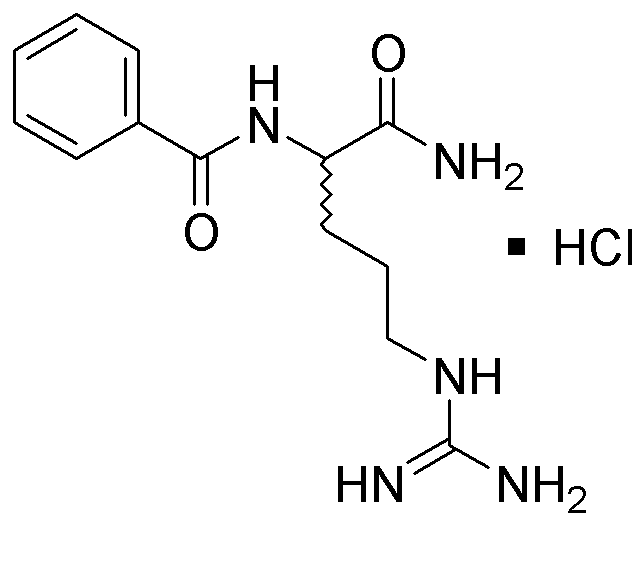Na-Benzoyl-DL-arginine hydrochloride is widely utilized in research focused on:
- Pharmaceutical Development: This compound serves as a key intermediate in synthesizing various pharmaceuticals, particularly those targeting cardiovascular and metabolic disorders.
- Biochemical Research: It is used in studies involving protein interactions and enzyme activity, helping researchers understand complex biological processes.
- Cosmetic Formulations: The compound is incorporated into skincare products for its potential to enhance skin hydration and improve overall skin texture.
- Food Industry: It acts as a preservative or flavor enhancer, contributing to food safety and quality in various processed products.
- Diagnostic Applications: This chemical is utilized in developing diagnostic assays, particularly in detecting specific biomarkers in clinical samples.
Informations générales
Propriétés
Sécurité et réglementation
Applications
Na-Benzoyl-DL-arginine hydrochloride is widely utilized in research focused on:
- Pharmaceutical Development: This compound serves as a key intermediate in synthesizing various pharmaceuticals, particularly those targeting cardiovascular and metabolic disorders.
- Biochemical Research: It is used in studies involving protein interactions and enzyme activity, helping researchers understand complex biological processes.
- Cosmetic Formulations: The compound is incorporated into skincare products for its potential to enhance skin hydration and improve overall skin texture.
- Food Industry: It acts as a preservative or flavor enhancer, contributing to food safety and quality in various processed products.
- Diagnostic Applications: This chemical is utilized in developing diagnostic assays, particularly in detecting specific biomarkers in clinical samples.
Documents
Fiches de données de sécurité (FDS)
La FDS fournit des informations de sécurité complètes sur la manipulation, le stockage et l’élimination du produit.
Spécifications du produit (PS)
Le PS fournit une description complète des propriétés du produit, notamment sa composition chimique, son état physique, sa pureté et les exigences de stockage. Il détaille également les plages de qualité acceptables et les applications prévues du produit.
Certificats d'analyse (COA)
Recherchez des certificats d'analyse (COA) en saisissant le numéro de lot du produit. Les numéros de lot et de lot se trouvent sur l'étiquette d'un produit, après les mots « Lot » ou « Lot de fabrication ».
Numéro de catalogue
Numéro de lot/série
Certificats d'origine (COO)
Ce certificat d'exploitation confirme le pays dans lequel le produit a été fabriqué, et détaille également les matériaux et composants utilisés et s'il est issu de sources naturelles, synthétiques ou autres sources spécifiques. Ce certificat peut être requis pour les douanes, le commerce et la conformité réglementaire.
Numéro de catalogue
Numéro de lot/série
Fiches de données de sécurité (FDS)
La FDS fournit des informations de sécurité complètes sur la manipulation, le stockage et l’élimination du produit.
DownloadSpécifications du produit (PS)
Le PS fournit une description complète des propriétés du produit, notamment sa composition chimique, son état physique, sa pureté et les exigences de stockage. Il détaille également les plages de qualité acceptables et les applications prévues du produit.
DownloadCertificats d'analyse (COA)
Recherchez des certificats d'analyse (COA) en saisissant le numéro de lot du produit. Les numéros de lot et de lot se trouvent sur l'étiquette d'un produit, après les mots « Lot » ou « Lot de fabrication ».
Numéro de catalogue
Numéro de lot/série
Certificats d'origine (COO)
Ce certificat d'exploitation confirme le pays dans lequel le produit a été fabriqué, et détaille également les matériaux et composants utilisés et s'il est issu de sources naturelles, synthétiques ou autres sources spécifiques. Ce certificat peut être requis pour les douanes, le commerce et la conformité réglementaire.


